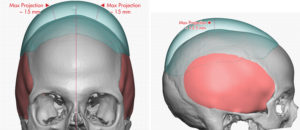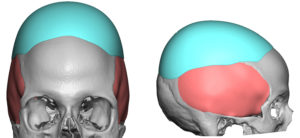Background: The size of one ’s head is a personal matter based on how one sees it. Some people feel their head is too big while others feel it is too small. While there are specific ratios and numbers for head to face size, what ultimately matters is how the person themselves see it. I have seen a lot of patients with concerns about their head size and in most the cases their concerns are visibly evident.
A larger head is hard to hide but a smaller head size can be camouflaged through a variety of head wear and hairstyles. Women can camouflage a smaller head size using their hair. Fuller hairstyles give the illusion of a bigger head. But eventually some women tire of the effort of making their hair a certain way or their hair becomes damaged by continually doing so.
The small head can be augmented to some degree using custom skull implants. The thickness of the skull bone can be doubled in many cases to create an overall larger head size. How much a skull implant can do so depends on the natural stretch of the scalp, which can not be precisely determined beforehand. My experience has shown that about 12mms of central implant thickness can be tolerated in most people. The scalp can safely stretch over an implant and allow for a comfortable incisional closure. More implant thickness or volume requires a first-stage scalp expansion procedure.


A scalp tissue expander was placed in a first operation with a remote port placed under the skin above the right ear. She was able to place 110cc of saline volume into the expander over the next six weeks.


Larger or more extreme skull augmentation require scalp expansion first. At the time of the implant placement the capsule from the expander misty bone removed from the bone as well as from the edges of the expander capsule. This will allow the scalp to fully maximize its expansion through these scar releases.
Highlights:
- The size of any skull implant depends on the stretch of the soft tissue to accommodate it.
- Larger skull augmentations require a first-stage skull expansion to ensure that there will be enough scalp to close over it.
- The timing between the placement of a scalp tissue expander and the secondary placement of a skull implant is usually around six weeks.
Dr. Barry Eppley
Indianapolis, Indiana




